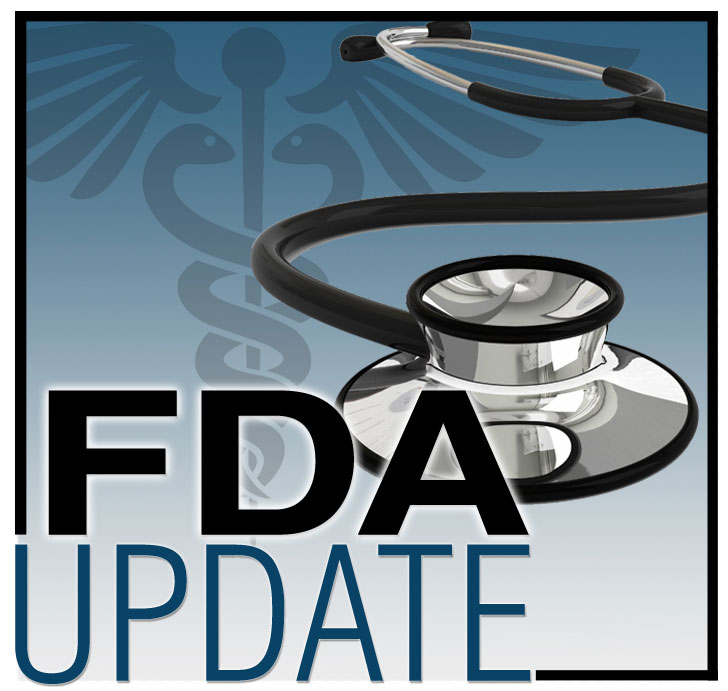
On May 10, 2017, the U.S. Food and Drug Administration (FDA) granted accelerated approval to pembrolizumab in combination with pemetrexed and carboplatin for the treatment of patients with previously untreated, metastatic, non-squamous, non-small cell lung cancer (NSCLC).
Approval was based on a cohort (G1) of patients enrolled in an open-label, multicenter, multi-cohort study (KEYNOTE-021). A total of 123 patients with locally advanced or metastatic non-squamous NSCLC and no prior systemic treatment for metastatic disease were enrolled. Patients were randomized to receive either 200 mg of pembrolizumab every three weeks in combination with pemetrexed and carboplatin (PC) for four cycles followed by pembrolizumab for a maximum of 24 months (n = 60) compared to PC alone (n = 63). At the investigator’s discretion, patients in both arms may have received pemetrexed as maintenance therapy. Randomization was stratified by PD-L1 tumor expression (tumor proportion score [TPS] < 1% versus TPS ≥ 1%).
The trial demonstrated an improvement in overall response rate (ORR) and in progression-free survival (PFS) for patients randomized to pembrolizumab plus PC. The ORR was 55% (95% CI = 42%-68%) for the pembrolizumab plus PC arm and 29% (95% CI = 18%-41%) for the PC alone arm (p = 0.0032). Among responders, the proportion of patients with response durations of 6 months or longer was 93% in the pembrolizumab-containing arm and 81% in the PC alone arm. The hazard ratio for PFS was 0.53 (95% CI = 0.31, 0.91, p = 0.0205) and the median PFS was 13.0 months (95% CI = 8.3, NE) for the pembrolizumab plus PC arm and 8.9 months (95% CI = 4.4, 10.3) for the PC alone arm. Exploratory analyses of ORR were conducted in subgroups defined by PD-L1 tumor expression (TPS < 1% and TPS ≥ 1%). In the TPS < 1% subgroup, the ORR was 57% and 13% in the pembrolizumab plus PC and in the PC alone arms, respectively. In the TPS 1% or greater subgroup, the ORR was 54% and 38% in the pembrolizumab plus PC and in the PC alone arms, respectively.
Adverse events (AEs) and serious AEs were observed at a higher incidence with the addition of pembrolizumab to PC compared to PC alone in patients from Cohort G1. Serious AEs occurred in 41% of the patients in the pembrolizumab plus PC arm compared with 28% in the PC alone arm. The most common AEs (all grades) in the pembrolizumab plus PC arm were fatigue (71%), nausea (68%), and constipation (51%). The most common grade 3-4 adverse reactions were fatigue (3.4%), dyspnea (3.4%), nausea (1.7%), vomiting (1.7%), diarrhea (1.7%), and rash (1.7%). Pembrolizumab was discontinued for adverse reactions in 10% of patients. The most common adverse reaction resulting in discontinuation of pembrolizumab (≥ 2%) was acute kidney injury (3.4%).
Immune-mediated adverse reactions can occur with pembrolizumab, including pneumonitis, colitis, hepatitis, endocrinopathies, and nephritis. Based on the severity of an adverse reaction, pembrolizumab should be withheld or discontinued and corticosteroids administered when appropriate.
The recommended pembrolizumab dose and schedule for NSCLC is 200 mg as an IV infusion every three weeks until disease progression, unacceptable toxicity, or up to 24 months in patients without disease progression.
Full prescribing information for pembrolizumab is available.
FDA granted pembrolizumab priority review status and accelerated approval for this indication. An additional study is required to confirm clinical benefit of pembrolizumab in combination with chemotherapy for this indication. A description of FDA expedited programs is in the Guidance for Industry: Expedited Programs for Serious Conditions-Drugs and Biologics.
Healthcare professionals should report all serious adverse events suspected to be associated with the use of any medicine and device to FDA’s MedWatch Reporting System by completing a form online, by faxing (800-FDA-0178) or mailing the postage-paid address form provided online, or by telephone (800-FDA-1088).
Follow the Oncology Center of Excellence on Twitter @FDAOncology.
In collaboration with the FDA and as a service to our members, ONS provides updates on recent FDA approvals and other important FDA actions (e.g., updated safety information, new prescribing information) pertaining to therapies for patients with cancer. This allows the agency to inform oncologists and professionals in oncology-related fields in a timely manner. Included in the FDA updates is a link to the product label or to other sites for additional relevant clinical information. In supplying this information, ONS does not endorse any product or therapy and does not take any position on the safety or efficacy of the product or therapy described.





